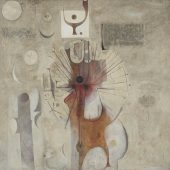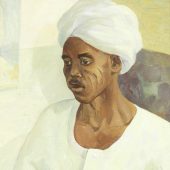Ibrahim El-Salahi
A foundational figure of African modernism, Sudanese artist Ibrahim El-Salahi creates intricately detailed compositions that draw on Islamic, African, Arab, and Western artistic traditions. His career spans over five decades and during this time El-Salahi’s practice has undergone a number of transformations, ignited by his devotion to experimenting with an array of visual sources and his spiritual process. In The Last Sound, a fascinating amalgam of muted abstract shapes and curved, angular lines are sparsely balanced across the square canvas. El-Salahi’s rhythmic articulation of Arabic calligraphy show his engagement in the letterist movement hurufiyyah, which gained in popularity during the 1950s and 1960s as addressing the formal concerns of modernism and politics of post-coloniality. Referencing the passing of his father, a Muslim cleric, the painting’s title The Last Sound invokes the final elusive sound of a soul’s divine passage from the corporeal world to the eternal one. Making reference to the prayers for the deceased in Sufi Islamic practice, this work poignantly culminates El-Salahi’s view throughout his career that his creative production is channeled through his commitment to a spiritual process.
El-Salahi studied painting at the School of Design at Gordon Memorial College from 1949 until 1951 in Khartoum before moving to London to study calligraphy. Following his return from studying at the Slade School of Fine Art in London between 1954 and 1957, where he began to incorporate modernist styles, El-Salahi developed a revitalised interest in the aesthetics of local Sudanese handicrafts. He taught at the College of Fine and Applied Art in Khartoum, where he spearheaded the major art movement known as the Khartoum School in 1960. El-Salahi also studied black-and-white photography in the Department of Journalism, School of General Studies, Columbia University, New York from 1964 to 1965 and traveled across the U.S., Mexico and Brazil. His work has been exhibited widely including his major retrospective at the Sharjah Art Museum in 2012 and at London’s Tate Modern in 2013.
يعتبر الفنان السوداني إبراهيم الصلحي أحد مؤسسي حركة الحداثة في الفن الأفريقي، وتحفل إبداعاته بالتفاصيل الدقيقة المستمدة من التقاليد الفنية الإسلامية والإفريقية والعربية والغربية. وتمتد مسيرة الصلحي الفنية على مدى خمسة عقود شهد أسلوبه الفني خلالها تحولاتٍ عديدة بدافع من التزامه بتجريب العديد من المصادر المرئية وكينونته الروحية. وتتضمن لوحته \"الصوت الأخير\" مزيجاً مدهشاً من الأشكال التجريدية الصامتة والخطوط الزاوية المنحنية التي تتوازن على نحو متناثر في أرجاء اللوحة القماشية المربعة. ويُظهر التعبير الإيقاعي للكتابة العربية في اللوحة اهتمام الصلحي بحركة الحروفية التي حققت انتشاراً واسعاً خلال خمسينيات وستينيات القرن الماضي لمعالجتها المخاوف المنهجية من حركة الحداثة وسياسات ما بعد الكولونيالية. وفي إشارة إلى وفاة والده الذي كان رجل دين مسلماً، يستحضر عنوان اللوحة إلى الأذهان الصوت المرتبِك الأخير للروح أثناء انتقالها من العالم المادي إلى العالم الأبدي. ومع الإشارة أيضاً إلى صلاة الميت على الطريقة الإسلامية الصوفية، يكلل هذا العمل الفني رؤية الصلحي عبر مسيرته الفنية التي تشكلت خلالها معالم نتاجه الإبداعي من خلال التزامه بالكينونة الروحية.
درس الصلحي الرسم في مدرسة التصميم التابعة لكلية غوردون التذكارية في الخرطوم بين عامي 1949 و1951، وانتقل بعدها إلى لندن لدراسة فن الخط. وبعد عودته من الدراسة في مدرسة سليد للفنون الجميلة بلندن بين عامي 1954 و1957، بدأ الصلحي بإدخال الأساليب الحداثية إلى فنه، وازداد اهتمامه بجماليات الحِرَف اليدوية المحلية في السودان. وعمل الصلحي مدرِّساً في كلية الفنون الجميلة والتطبيقية بالخرطوم، حيث تزعّم عام 1960 حركة الفن الحديث المعروفة باسم \"مدرسة الخرطوم\". ودرَس بين عامي 1964 و1965 التصوير الفوتوغرافي بالأبيض والأسود في كلية الصحافة بمدرسة الدراسات العامة التابعة لجامعة كولومبيا في نيويورك، وتنقّل خلال تلك الفترة بين الولايات المتحدة والمكسيك والبرازيل. وعُرضت أعماله الفنية على نطاق واسع بما في ذلك المعرض الاستعادي لأعماله في متحف الشارقة للفنون عام 2012، وفي متحف تيت مودرن بلندن عام 2013.






